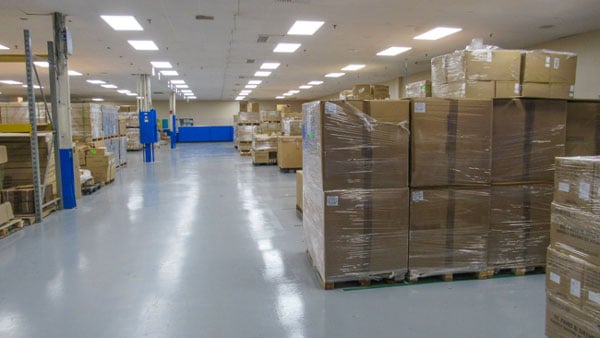Running production operations is a daunting task for manufacturers. You want your operations to be highly productive, flexible with the changing needs of customers, and to run efficiently. At the same time, you want to develop ways to reduce process costs without reducing the quality of works-in-progress (WIP) parts or finished contracted products.
Yet, there are many issues that manufacturers face when trying to effectively manage their inventory. If your manufacturing company takes orders on the fly, you need the required amount of raw materials or parts available from suppliers. In addition, you'll want a set amount of WIP parts or end products to be manufactured during the production run to gain a return on investment and justify process costs.
However, ordering raw materials from suppliers isn't always reliable. Costs can increase when ordering smaller material shipments at unpredictable times. Also, logistical and delivery hurdles can appear at any time, hampering production times and deadline schedules.
In other instances, you don't want to create a large amount of WIP parts or products ahead of time in the hopes that there will be product orders waiting in the near future. With consumer demand always fluctuating, you may wind up having products sitting on warehouse shelves and taking up room. This issue can increase warehouse carrying costs due to overstocking. Also, if the part or product becomes obsolete, you must deal with the increased costs of disposing the extra inventory stock. This disposal process can be difficult, or sometimes not feasible, with certain raw materials that are dangerous or hazardous to the environment.

With inventory management strategies, you can lower excessive inventory levels.
Contract manufacturers and original equipment manufacturers (OEMs) use effective inventory management strategies to improve their workflow processes and inventory. These strategies focus on meeting the required production levels while being responsive and flexible to purchase orders. There are several advantages to having an inventory management system designed based on your manufacturing operations and needs.
Reduce Overall Financial Exposure with KanBan Systems
A problem that leads to a rise in financial costs involves the production schedules of the OEM or contract manufacturer that does not align with your company's manufacturing or warehousing needs. You have a set inventory level that may fluctuate based on customer demand. Yet, OEM and contract manufacturers try to avoid sending out smaller parts and WIP orders at unpredictable and varying schedules, as this factor increases production, storage, and transportation costs. If they have to send out multiple smaller orders instead of filling up trucks to capacity for one large shipment, they will typically pass the increased costs onto their customers as this sends your budget out of control.
A KanBan inventory management system helps reduce such financial exposure by utilizing just-in-time production processes combined with real-time, visual replenishment systems. KanBan focuses on consumption activity when a product is pulled from inventory. It tracks parts and WIP usage rates that help to develop a current production and supply schedule. With this visual data, the manufacturer, as well as the OEM or contract manufacturer, can agree on the right inventory levels to have, where they are stored, and when the parts and components will be shipped by streamlining the supply chain process.
Receive Favorable Pricing with Consignment Strategies
When working with OEM and contract manufacturers, they want to create a set high volume amount that allows them to better manage production run processes and related costs. To encourage customers to make higher volume purchases, manufacturers encourage the use of blanket orders with favorable negotiated pricing schemes.
However, you may not want that many products, which you know will just sit on shelves until an order comes through, just to get a lower quote. Switching over to an inventory management strategy allows you to receive the negotiated lower price for the lower set amount of purchased products and parts. The inventory program agreement with the manufacturer ensures that you are only liable to pay for those parts and products that you will use to fill orders. The products can be stored at your facilities, or with the manufacturer’s facility, as you have greater control over your inventory levels.
Using inventory management strategies, you obtain more favorable pricing based upon the agreement on how many products and WIP parts are used. So, unused inventory costs will not be passed onto you. Even though the OEM parts and WIP products are stored at your facility, the OEM and contract manufacturer will officially own the items. You only pay when the part or product is used or opened.
Additional Benefits with KanBan and Consignment Inventory Strategies
Improve Inventory Turnover
With inventory management strategies, you can lower excessive inventory levels. Excessive warehouse inventory may happen during certain times of the year when sales are predictably slow. OEMs and contract manufacturers understand this issue as they seek to strike a balance between having enough WIP parts and finished goods to meet demand without overstocking their shelves. The manufacturers can ensure that they are not carrying too many products that will not be ordered, and you ensure that your warehouse will not be packed with products beyond capacity.
This process is accomplished with open and honest inventory management communication combined with KanBan strategies. By providing details regarding the supply chain, production lead times, and volume orders, you can ensure that your turnover rates are strong where you have high sales with enough inventory stock because you will only be pulling parts and products when required. Instead of using forecasted demand trends, which may not align with actual sales rates, KanBan works by using real-time demand rates. Every time a product is pulled from shelves, it triggers a replenishment action that needs to be fulfilled.
Provides Positive Cash Flow
Effective inventory management involves managing your cash flow in the long term by understanding how many parts and finished goods are used throughout the year. Then you can communicate your inventory needs with your manufacturing partner to gain a set low quote that works with your budget. You save money only on the inventory you need, when you need it, and only when you have the available warehouse space to hold it. Then you only pay for what you use as this reduces your handling and storage costs.
Another factor with better inventory management also involves having the cash flow to develop new product lines. By not overstocking on products at facilities, it gives you the opportunity to create new product lines. The OEM and contract manufacturer can perform more effective changeovers for the new production runs.
Improve Lead Times
When an order arrives at the OEM and contract manufacturer, they assign it to their work processes. There may be a lead time between when the order was placed, when the WIP or finished product will be manufactured, and when it will be delivered. This factor is due to the OEM or contract manufacturer trying to balance their schedule to handle all the orders that may be coming in. During busy seasons, you may see lead times that stretch to four to six weeks, as you are left waiting for the parts or products to arrive to proceed with your regular manufacturing schedule.
To improve lead times, OEM and contract manufacturers seek to form agreements to carry a certain amount of finished goods and WIP parts that are stored at their manufacturing sites. Then, they can send out this stock during specified times or when an order is placed. These agreements are called blanket purchase orders and estimated annual usage (EAU) agreements.
Using blanket purchase orders and EAUs can improve your lead times with your suppliers. Instead of waiting for the OEM and contract manufacturer to create the WIP part or finished good on the spot, they can send out the order immediately because it is already available on their shelves. So, a previous lead time of four to six weeks is changed to 24 to 48 hours. You can receive the parts only when you need them, without dealing with warehouse carrying costs; you won't need to make shelf space for any products that are released based on a set schedule.
Seek Out the Inventory Management Appropriate for Your Operations
Every company operates differently as well as carries stock based on their specific product demands. Analyzing historical purchases and present sales trends will help give you a clearer look into present operations and where inventory management will help with supply chain obstacles. In addition, if you already have inventory management strategies in place, don't forget to continuously review present operations to ensure these strategies are still meeting the needs of the company.
Business expansion and growth can continually change the needs of supply chain operations. Revisiting set policies and strategies allows you to stay on top of your inventory management and make changes that adequately reflect the present workflow to maintain productivity, flexibility, and responsiveness of your operations. In addition, you will also be able to create strong business relationships with the OEM and contract manufacturers that you use or seek out new partnerships that better align to your present as well as future supply chain needs.
Summary
Effective inventory management helps manufacturers reduce financial risks, balance supply and demand, and avoid costly overstocking or shortages. By adopting strategies such as KanBan systems and consignment agreements, companies can lower costs, improve lead times, maintain positive cash flow, and strengthen supplier relationships. This approach creates a more agile and cost-efficient operation while supporting long-term growth.
Key Takeaways
- Lower Financial Risk with KanBan: Just-in-time inventory and visual replenishment systems reduce unnecessary stockpiling and align production more closely with real-time demand.
- Consignment Agreements Improve Pricing: You pay only for the parts or products you use, allowing access to negotiated volume pricing without carrying excess inventory costs.
- Better Inventory Turnover: Real-time demand tracking ensures stock moves efficiently, preventing costly overstock during slow sales cycles.
- Stronger Cash Flow: Paying only when products are used reduces storage expenses and frees up capital for new product development or other investments.
- Improved Lead Times with Blanket Orders: Pre-arranged agreements allow faster delivery (from weeks to days), ensuring parts are available when needed without bloating warehouse capacity.
















